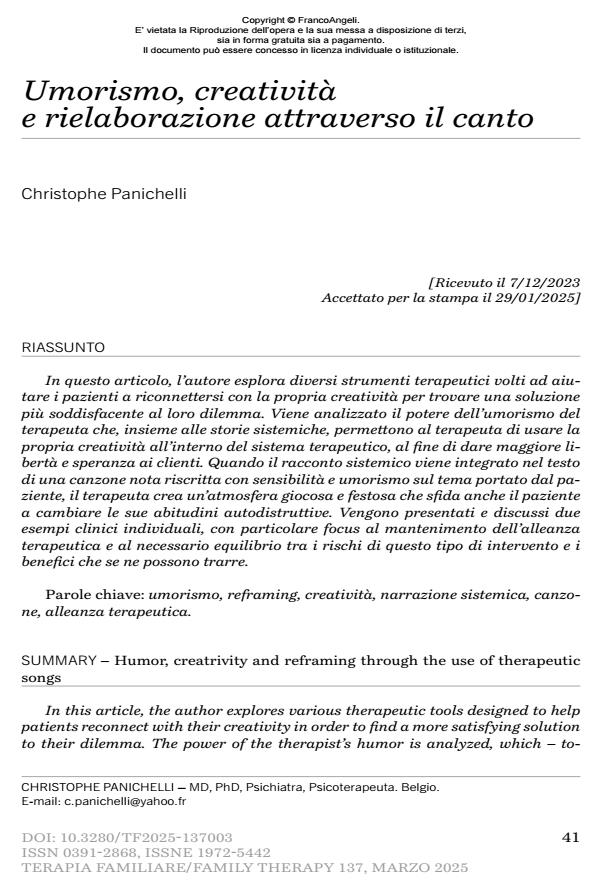Umorismo, creatività e rielaborazione attraverso il canto
Titolo Rivista TERAPIA FAMILIARE
Autori/Curatori Christophe Panichelli
Anno di pubblicazione 2025 Fascicolo 2025/137
Lingua Italiano Numero pagine 14 P. 41-54 Dimensione file 158 KB
DOI 10.3280/TF2025-137003
Il DOI è il codice a barre della proprietà intellettuale: per saperne di più
clicca qui
Qui sotto puoi vedere in anteprima la prima pagina di questo articolo.
Se questo articolo ti interessa, lo puoi acquistare (e scaricare in formato pdf) seguendo le facili indicazioni per acquistare il download credit. Acquista Download Credits per scaricare questo Articolo in formato PDF

FrancoAngeli è membro della Publishers International Linking Association, Inc (PILA)associazione indipendente e non profit per facilitare (attraverso i servizi tecnologici implementati da CrossRef.org) l’accesso degli studiosi ai contenuti digitali nelle pubblicazioni professionali e scientifiche
In questo articolo, l’autore esplora diversi strumenti terapeutici volti ad aiutare i pazienti a riconnettersi con la propria creatività per trovare una soluzione più soddisfacente al loro dilemma. Viene analizzato il potere dell’umorismo del terapeuta che, insieme alle storie sistemiche, permettono al terapeuta di usare la propria creatività all’interno del sistema terapeutico, al fine di dare maggiore libertà e speranza ai clienti. Quando il racconto sistemico viene integrato nel testo di una canzone nota riscritta con sensibilità e umorismo sul tema portato dal paziente, il terapeuta crea un’atmosfera giocosa e festosa che sfida anche il paziente a cambiare le sue abitudini autodistruttive. Vengono presentati e discussi due esempi clinici individuali, con particolare focus al mantenimento dell’alleanza terapeutica e al necessario equilibrio tra i rischi di questo tipo di intervento e i benefici che se ne possono trarre.
Parole chiave:umorismo, reframing, creatività, narrazione sistemica, canzone, alleanza terapeutica.
- Andolfi M., Angelo C., de Nichilo (1987). Temps et mythe en psychothérapie familiale. Parigi: ESF.
- Andolfi M. (2023). L’authenticité en thérapie. Quand l’histoire du thérapeute rencontre celle du patient et de sa famille. Louvain-la-Neuve: De Boeck supérieur.
- Ausloos G. (1995). La compétence des familles. Ramonville: Erès.
- Cade B. (1982). Humour and creativity. Journal of Family Therapy, 4: 35-42.
- Cade B. (1992). A response, by any other… Journal of Family Therapy, 14: 163-169.
- Caillé P., Rey Y. (2004). Les objets flottants, Méthodes d’entretiens systémiques. Parigi: Fabert.
- Ellis A. (1977). Fun as psychotherapy. Rational Living, 12(1): 2-6.
- Ellis A. (1987). The use of rational humorous songs in psychotherapy. In: Fry W.F. & Salameh W.A., Handbook of Humor and Psychotherapy (pp. 265-285). Sarasota: Professional Resource Exchange.
- Elkaïm M. (2001). Si tu m’aimes, ne m’aime pas (édition augmentée). Parigi: Le Seuil. Elkaïm M. & Stengers I. (1994). Du mariage des hétérogènes. In: Szafran A.W. & Nysenholc A., Freud et le rire (pp. 106-126). Paris: Métailié.
- Farrelly F., Brandsma J. (2000). La thérapie provocatrice. Bruxelles: Satas.
- Farrelly F. & Lynch M. (1987). Humor in provocative therapy. In: Fry W.F. & Salameh W.A., Handbook of Humor and Psychotherapy (pp. 81-106). Sarasota: Professional Resource Exchange.
- Friedlander M.L., Escudero V. & Heatherington L. (2006). Therapeutic Alliances in Couple and Family Therapy. Washington DC: American Psychological Association.
- Greenwald H. (1975). Humor in Psychotherapy. Journal of Contemporary Psychotherapy, 7(2): 113-116.
- Janne P., Dessoy E. (1999). Intérêt et place du “Recadrage” en thérapie familiale: une relecture du concept initiée par un sonnet de Charles Baudelaire. Thérapie familiale, 20(3): 275-285.
- Johnston R.A. (1990). Humor: a preventive health strategy. International Journal for the Advancement of Counselling, 13: 257-265.
- Kuiper N.A., McKenzie S.D., Belanger K.A. (1995). Cognitive appraisals and individual differences in sense of humor: Motivational and affective implications. Personality and Individual Differences, 19(3): 359-372. DOI: 10.1016/0191-8869(95)00072-E
- Metzger J.A. (2014). Adaptive defense mechanisms: function and transcendence. Journal of Clinical Psychology: In Session, 70(5): 478-488.
- Minuchin S., Fishman H.C. (1981). Family therapy techniques. Cambridge/Londra: Harvard University Press.
- Napier N.Y., Whitaker C.A. (1978). The Family Crucible: The Intense Experience of Family Therapy. New York: Harper & Row.
- Panichelli C. (2006). L’humour en psychothérapie: le recadrage peut-il être recadrôle? Thérapie Familiale, 27(4): 399-418.
- Panichelli C. (2013). Humor, joining and reframing in psychotherapy: Resolving the auto-double-bind. American Journal of Family Therapy, 41(5): 437-451. DOI: 10.1080/01926187.2012.755393
- Panichelli C. (2017). Un tango au pays du rire. L’utilisation de l’humour avec l’adolescent en thérapie familiale. Percentile, 22(6): 30-33.
- Panichelli C. (2023). La thérapie par le rire. Introduire l’humour en psychothérapie. Bruxelles: Mardaga.
- Panichelli C., Albert A., Donneau A.F., D’Amore S., Triffaux J.M., Ansseau M. (2018). Humor Associated with Positive Outcomes in Individual Psychotherapy. American Journal of Psychotherapy, 71(3): 95-103.
- Panichelli C. & Hayez J.-Y. (2022). Réguler la dimension autodestructrice de Soi. Perspectives Psy, 61(1): 54-61.
- Panichelli C., Panichelli-Batalla S. (2018). Humorous Sublimation of a Dying Cuban Writer in Reinaldo Arenas’ The Color of Summer. Humor: International Journal of Humor Research, 31(4): 623-643.
- Watzlawick P. (1978). La réalité de la réalité. Parigi: Seuil, Points Essais. Watzlawick P. (1993). Foreword. In: Fry & Salameh (eds.), Advances in Humor and Psychotherapy, Sarasota, Florida: Professional Resource Press.
- Winnicott D.W. (1975). Jeu et réalité. L’espace potentiel. Paris: Gallimard.
Christophe Panichelli, Umorismo, creatività e rielaborazione attraverso il canto in "TERAPIA FAMILIARE" 137/2025, pp 41-54, DOI: 10.3280/TF2025-137003